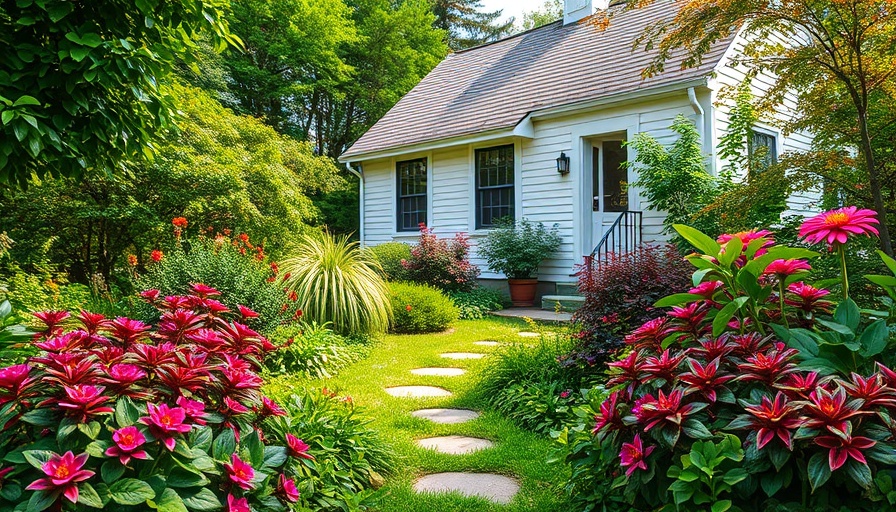
Unlocking the Beauty of Circle Gardens
Are you ready to transform your outdoor space into a captivating oasis? The circle garden stands as a beacon of beauty and balance, drawing attention with its symmetry and inviting charm. With the right designs and plant choices, a circle garden can evolve from an ordinary lawn into a stunning retreat that serves both purposes—a place for relaxation and a hub for gathering.
Purpose-Driven Design
The first step in creating a captivating circle garden is to define its purpose. Whether you're aiming for a peaceful meditation spot, a vibrant pollinator sanctuary, or a lively entertainment space, understanding how you plan to use the garden shapes the design. A garden that fosters joy and connection can enhance your overall landscape, encouraging visitors to gather and enjoy the inviting energy of the space.
Research shows that circular designs promote positivity and comfort. According to Feng Shui principles, they symbolize unity and encourage a sense of well-being, which is crucial in any outdoor setting. By creating a space that not only looks good but feels good, you're ensuring that your circle garden functions as a true extension of your home.
Selecting the Ideal Location
Now that you know the purpose, the next vital step is choosing the perfect location. Consider factors like sunlight, wind direction, and accessibility when positioning your circle garden. A central and open area can help your garden make a striking statement, while a more tucked-away spot might create a cozy retreat away from the hustle of daily life.
Placement should also reflect your landscape’s natural flow, harmonizing with existing elements like patios, pathways, and other features. The ideal location enriches not only the garden itself but also the overall aesthetic of your backyard, helping to create a seamless outdoor sanctuary.
Choosing Plants for Vibrancy and Balance
Choosing the right plants can elevate the appearance and function of a circle garden. Consider selecting a range of flora that blooms in different seasons, ensuring year-round allure. Tall, striking flowers can provide vertical interest while low ground covers help create a defined edge.
Bringing together a variety of textures and colors will enhance the garden's visual impact. The goal is to achieve balance akin to an artist's palette—allowing your circle garden to express itself through layers of beauty. Think about incorporating plants that attract pollinators and encourage biodiversity, turning your garden into a thriving ecosystem.
Paths That Lead the Way
No circle garden is complete without functional pathways. These walkways not only guide visitors through your outdoor space but also enhance the aesthetic appeal. Curved paths are particularly effective, complementing the circular shape of the garden while adding an element of whimsy.
A well-planned pathway connects different sections of the garden and invites exploration. Consider using natural materials such as gravel, stone, or wood to maintain an organic feel that harmonizes with the surrounding landscape. However, functionality is crucial; ensuring these paths are practical and durable will increase their utility and beauty.
Creating Comfortable Spaces for Relaxation
Incorporating seating areas within your circle garden can transform it into a welcoming retreat. Whether it’s comfy benches surrounded by lush greenery or casual seating near a fire pit, these elements invite people to enjoy the tranquility of your garden space. Comfortable seating allows for relaxation and social interactions, further enhancing the garden's role as a gathering place.
Utilize natural materials like wood or stone for your seating arrangements, ensuring they blend seamlessly with the landscape. Adding cushions or decorative pillows can provide an extra touch of comfort and style. The goal is to create an inviting atmosphere that encourages people to linger and appreciate the natural beauty around them.
The Impact of Water Features
Including water features like fountains or small ponds in your circle garden can boost its ambiance significantly. The soothing sound of flowing water creates a serene atmosphere, enhancing the garden's meditative qualities. Positioning these features centrally within the circular layout can attract attention and provide a focal point around which the rest of the garden can thrive.
Water elements not only serve an aesthetic purpose; they also support local biodiversity and attract wildlife, making your garden an ecological haven. Remember that every aspect of your circle garden can enrich its overall purpose—beauty combined with functionality leads to sustainable outdoor living.
Final Thoughts
Designing a stunning circle garden takes careful planning and creative expression. By setting a clear purpose, choosing the right location and plants, creating inviting spaces and paths, and considering water features, you can create an enchanting outdoor sanctuary where beauty and balance intertwine.
Remember, the journey of crafting your circle garden is an opportunity for personal expression and connection with nature. Don't rush the process; take time to engage with your landscape, let it speak to you, and allow your creativity to flourish!
If you’re excited to uncover more tips and expert advice, consider exploring our resources on enhancing outdoor spaces—your dream garden awaits!
 Add Row
Add Row  Add
Add 




Write A Comment